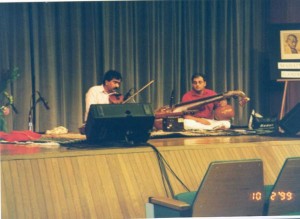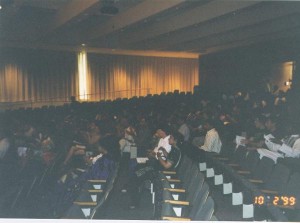Indian classical music concert
October 2, 1999
Sri Lalgudi Krishnan and his group enthralled the audience with a melodious performance that left the audience asking for more even after over three hours of perfect rendition of Carnatic Instrumental music. The trio comprising of Sri Krishnan, Sri Chary and Sri Brahmanandam started the evening with a varnam in Neelambari (which is a composition of their Guru Sri Lalgudi Jayaraman) amidst a nearly packed audience in Kresge Auditorium at Stanford University. The concert was organized by Asha-Stanford to mark the 130th birth anniversary of Mahatma Gandhi. Subsequently they performed several popular ragas as the evening progessed. The highlight of the evening was the Ragam Thalam Pallavi set in Hemavathi in Khanda Jaathi Triputa Thalam. The choice of words was very germane to the event: “Shantha moorthy Gandhi Mahatma mani mozhi vazhi nadappom” (Let us follow the words of Mahatma Gandhi, who was an embodiment of Peace).
Sri Krishnan also gave some insights into the intricacies of some of their music for the benefit of audience not too familiar with Carnatic music. Given the diversity in the audience this was a most thoughtful and welcome gesture from the artists. Towards the end, the artists performed two of Gandhiji’s favorite bhajans “Vaishnava janatho” and “Raghupathi raghava raja ram”. They concluded the concert with a thillana in Karnaranjani (which is also a composition of their Guru). Altogether, their music captivated the audience and it was a great evening of Indian Classical Music.
Student volunteers from Wilcox High School helped Asha-Stanford make this event a success.
World Cup matches Telecast
Asha-Stanford made arrangements for the local cricket enthusiasts to watch the World Cup Cricket matches live. The event received an overwhelming response from a diverse mix of Indians, Australians, South Africans and Pakistanis to name a few. Arrangements were made for people to enjoy hot idlis and sambhar at breakfast time, for most of the well-attended matches. The event was a big success. More importantly, Asha-Stanford was able to reach out to many people in and around the Bay Area.
Holi celebration
Asha-Stanford organized Holi on Sunday, March 7th, 1999 at the patio of the Bechtel International Center, in Stanford University. The event was a huge success with a complete sell out crowd of nearly 300 people showing up with friends and family.
The event started at 11am in the lush green lawn in the patio of the Bechtel International Center. Apart from the usual sight of people smearing one another with colored powder and hugging one another with “Holi Mubaarak” or “Happy Holi” salutations, it was hilarious to see water balloons and water guns being effectively used to squirt colored water at unsuspecting people. Children specially had a great time playing with the water guns.
Even as some people were playing with the colors, some took to traditional Indian games like Pithoo and Kabaddi. An innovative way to play Musical Chairs without any chairs turned out to be a big success. In the midst of all this activity, Himanshu, Asha-Stanford’s own DJ, played a delightful mix of old and new Hindi film songs. The famous “Khaike paan Banaras waala..” song sung by Indian filmstar Amitabh Bachchan, set the tone. Men, women, children everyone joined in to dance without a care in the world. There were feverish requests for an encore on some of the songs, notable among them being Daler Mehndi’s hit song “Na Na Na Na Na Re. ..”, and the oldtime classic song “Uden jab jab zulfen teri..”. Amidst all this feverish dancing, some used the water hose to douse others while others threw colored powder in the air.
Even as the crowd continued dancing paying no heed to their tired bodies, some people had delightful Indian snacks like Chaat, Tikki, Samosa and Sweets at the food stall. Towards the end, an informal Antakshari and an Indian Mythological Quiz kept the crowd amused and provided a temporary rest after the nonstop dancing.
Check out this article from the The Stanford Daily reproduced here:
Asha celebrates Holi
By Ritu Bhatnagar, Editorial staff, The Stanford Daily
Published March 10th, 1999
Asha, a student-run organization that focuses on Indian cultural programming, held its first celebration of the East Indian festival Holi on March 7. The event, held at Bechtel International Center, was attended by about 300 people, including students and their families and friends.
“The event was a great success,” said doctoral student Pankaj Gupta, president of Asha. “We were expecting the event to be a moderate success, but the nature of the event generated lots of response.”
Asha means hope in several Indian dialects. Proceeds from Asha’s events aid children’s education projects in India.
Holi, which is the Indian festival of colors, marks the beginning of spring and a new harvest. The celebration is drawn from a story in Indian mythology, in which Prahlad, the son of the oppressive king Hiranyakashyap, triumphs over his father through the power of devotion.
“Holi is part of a big cultural festival in India and is tied to a couple of religious stories,” Gupta said. “The main thing about Holi is that it’s a common gathering and it’s a good way to have fun.”
At the event, participants smeared one another with colored powder or drenched each other with colored water, and many played traditional Indian games such as Pidhu and Kabaddi.
While Gupta said the event went smoothly for the most part, some students in neighboring dormitories such as Florence Moore Hall complained of the event’s loud music.
“We hope to solve outstanding issues with the dorms [for a future Holi event],” Gupta said.
“On the whole I’m very enthusiastic about the event in the future.”
While the event was attended mostly by Indian graduate students, doctoral student Shriram Ramanathan, a member of Asha and an organizer of Holi, said that he was pleased with the “fair number of individuals from other backgrounds who attended.”
“We were glad we could reach out,” he said.


